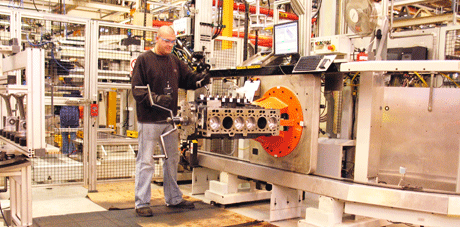Tier 4 emissions regs to make tractors more expensive

What does this mean for the future? Discuss the issue in the forums.
Tractor engines will get cleaner and easier to maintain in the next few years – but they’ll be more expensive, too. That’s the advice from Perkins, Britain’s biggest diesel engine maker, which is tooling up ready to make engines that meet the latest ultra-tough emissions regulations.
Until now, diesel engines in off-road vehicles haven’t had to meet the same standards on nitrous oxide and particulate emissions as their truck and car cousins. But that will all change in the next few years, with the next round of emissions cuts (called Tier 4 interim/Stage 3) due in 2011 and intended to drive down particulate output by 95% and nitrous oxides by 30%. Engine makers will then have until 2016 to cut nitrous oxides by another 90% under the Tier 4 final/Stage 4 round of cuts.
All this is costing engine makers like Perkins, Iveco, Cummins, Sisu and Deutz a small fortune in building sophisticated systems that avoid or trap the muck. And that means engine prices could rise by 30% to pay for all this clean engine technology.
There’s more than one system out there to cut emissions. Take exhaust baddie number one – nitrous oxide.

Finnish maker Sisu has started fitting a system called Selective Catalyst Reduction to its engines in the new Massey 8600s and Valtra S Series tractors. This involves injecting urea into the exhaust stream so that the ammonia in it catalyses the nitrous oxides into harmless nitrogen and water.
But Perkins says it has rejected this route because of the infrastructure required to supply and store the urea, especially in geographically big markets like the USA. Instead it has plumped for exhaust gas recirculation (EGR) on its new 1200 Series Tier 4/Stage 3 engines, which will go into production in two years’ time and include new seven-litre units up to 302hp.
EGR diverts 15% of the exhaust gas back into the engine’s air inlet. Because this air is high in moisture, it cools the engine hotspots where nitrous oxides form.
Then there’s baddie number two – particulates. These are tiny particles of unburnt fuel that have turned to soot and Perkins has a number of cards up its sleeve to either trap them or not produce them in the first place.
One is to fit twin turbos, one small and one large, to get more air through the engine. Another is boosting pressures in the engine’s common rail (where the fuel sits before heading for the injectors) from the current 1400-1600bar to a mighty 2000bar.
But the main plan is to fit particulate filters of the sort many of us already have lurking under our car bonnets.
These are made of a porous ceramic material and are very effective. But they do block, so engine makers have had to devise clever self-emptying systems involving catalysts or burn-off systems.
So the environment will definitely gain from less pollution. And farmers should get slightly better fuel consumption and longer service intervals thanks to car-style technology like hydraulic tappits.
Tractor, combine, handler makers, however, will have to find space for chunky particulate filters in the already-tight space under the bonnet. No surprise that Perkins expects its compact 175hp four-cylinder unit to be popular when it goes into production in 2010.
More seriously, makers will have to find ways to pass on the extra cost of these engines (a Tier 4/Stage 3 engine is expected to cost 30% more than its predecessor) to farmers. And selling these hi-tech-powered tractors second-hand to developing countries after a few years could be tricky, too.
What does this mean for the future? Discuss the issue in the forums.

